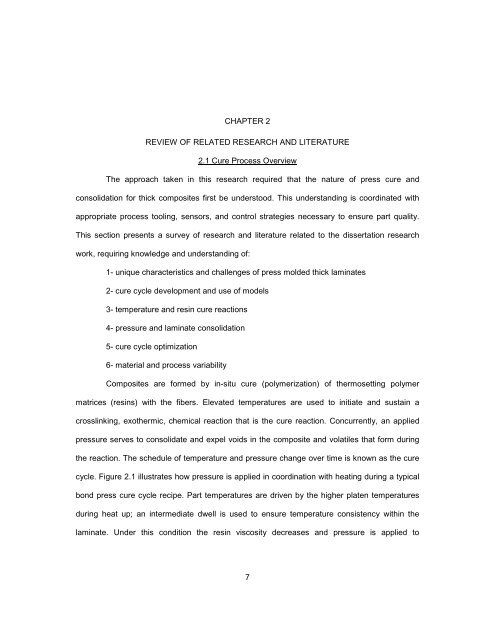TOOLED THICK COMPOSITES by ARVEN H. SAUNDERS III ...
TOOLED THICK COMPOSITES by ARVEN H. SAUNDERS III ...
TOOLED THICK COMPOSITES by ARVEN H. SAUNDERS III ...
Create successful ePaper yourself
Turn your PDF publications into a flip-book with our unique Google optimized e-Paper software.
CHAPTER 2<br />
REVIEW OF RELATED RESEARCH AND LITERATURE<br />
2.1 Cure Process Overview<br />
The approach taken in this research required that the nature of press cure and<br />
consolidation for thick composites first be understood. This understanding is coordinated with<br />
appropriate process tooling, sensors, and control strategies necessary to ensure part quality.<br />
This section presents a survey of research and literature related to the dissertation research<br />
work, requiring knowledge and understanding of:<br />
1- unique characteristics and challenges of press molded thick laminates<br />
2- cure cycle development and use of models<br />
3- temperature and resin cure reactions<br />
4- pressure and laminate consolidation<br />
5- cure cycle optimization<br />
6- material and process variability<br />
Composites are formed <strong>by</strong> in-situ cure (polymerization) of thermosetting polymer<br />
matrices (resins) with the fibers. Elevated temperatures are used to initiate and sustain a<br />
crosslinking, exothermic, chemical reaction that is the cure reaction. Concurrently, an applied<br />
pressure serves to consolidate and expel voids in the composite and volatiles that form during<br />
the reaction. The schedule of temperature and pressure change over time is known as the cure<br />
cycle. Figure 2.1 illustrates how pressure is applied in coordination with heating during a typical<br />
bond press cure cycle recipe. Part temperatures are driven <strong>by</strong> the higher platen temperatures<br />
during heat up; an intermediate dwell is used to ensure temperature consistency within the<br />
laminate. Under this condition the resin viscosity decreases and pressure is applied to<br />
7
















